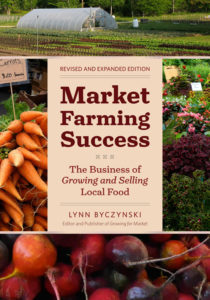Excerpted from Market Farming Success by Lynn Byczynski
Scheduling
After you have completed the exercise of figuring out how much to grow in order to meet income targets, you can get to work filling in your planting calendar. You can do this with a pencil on a big paper calendar or use a computer. First, mark your average first and last frost dates. The field season revolves around these two dates.
Then mark your day length for the first day of each month. For many plants, growth is ruled by photoperiod, which is the ratio of daylight to darkness. So it’s useful to become familiar with day length, the number of daylight hours between dawn and dusk. Day length depends on the time of year and your latitude (distance from the Earth’s equator). The Old Farmer’s Almanac always includes tables and charts that allow you to identify your latitude and calculate day length. Or you can find some quick calculators online that will do it for you.
Most plants don’t grow well with fewer than 11 hours of daylight, even if you can protect them from cold weather, so it’s useful to get in the habit of thinking in terms of day length. This will be especially helpful if you plan to extend the season with a hoophouse or grow all winter in a heated greenhouse. Also, onions are bred to be grown in certain areas based on day length, so you’ll need to understand the interaction between day length and temperature in your location to be able to choose the best onion varieties and grow them successfully.
Once you have your frost-free dates marked, line up your varieties according to when they can be planted outside. Mark those dates on the calendar, too. If you are going to grow the transplants yourself, count backward from the planting date to determine the seeding date. For such heat-loving crops as tomatoes, peppers, and melons, set a later date when the weather is warm—there’s no sense in rushing those summer crops because they aren’t going to thrive until it heats up anyway. Cool-loving crops, such as peas and spinach, can go a couple of weeks earlier. If you’re going to be planting in a hoophouse, you can schedule your first plantings as much as a month earlier than field plantings.
Although some growers still do these calculations on a paper calendar, most now use spreadsheets for planting plans. Johnny’s Selected Seeds has a calculator on its website that you can use as a model for creating your own calculations.
Succession Planting
To this point, you’ve done what every good backyard gardener does: starting in a timely fashion. When you’re growing for market, though, you have to keep planting as long as you possibly can hope to get a crop. Some crops (lettuce, for example) may be planted every week, up to the point where the weather will become too hot. Others can be planted every week to 10 days, up to the point where you can’t get them harvested before the first frost in fall. This is the more elaborate planning process, and it will require a lot of knowledge about your climate and the crops you are growing.
Season extension is the key to success in market farming. As long as you have a market, you should have as much to sell as possible. Experienced market gardeners work hard at extending the season for every crop they grow. They use row cover to protect against late and early frosts in spring and fall, black plastic mulch to warm the soil for heat-loving crops, shade cloth to keep cool-weather crops going into summer, succession plantings on almost every crop, and careful variety selection to stagger harvests.
Planning for all these crops is probably the most challenging job you will do, but I want to emphasize again: It’s the key to your success. In the first few years of farming, you will just have to guess at how long you can extend the season for each crop. As you gain experience, you will refine your planting calendar over and over.
You may also enjoy these excerpts from Market Farming Success:
This excerpt has been reprinted with permission from Market Farming Success by Lynn Bycynski and published by Chelsea Green, 2013.











